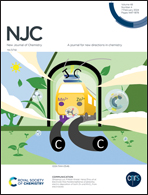Halogen-engineered metal–organic frameworks enable high-performance electrochemical glucose sensing†
Abstract
The introduction of halogen atoms into the skeleton to regulate the intrinsic properties or improve task-specific performance of metal–organic frameworks (MOFs) has developed rapidly in recent years. Herein, a series of halogen-engineered MOFs were designed and prepared for electrochemical glucose sensing. Three isomorphic Ni-MOFs were constructed by using tetra-halogenated-phthalic acids as the organic ligand and incorporating 4,4′-bipyridine as an auxiliary ligand. Halogen atoms can enhance the stability of Ni-MOFs through their hydrophobicity and interlayer halogen bonds (X–X or X–π, X = F, Cl, Br). Combined experimental and theoretical results show that the hydrogen bond between halogen atoms and glucose improves the reaction thermodynamics, enabling the wide linear range of 0.01–5.0 mM, high sensitivity of 4709.9 μA mM−1 cm−2 and low detection limit of 0.043 μM. This work provides practical guidance for the rational design of halogenated MOFs and promotes their applications in electrochemical sensing.



 Please wait while we load your content...
Please wait while we load your content...